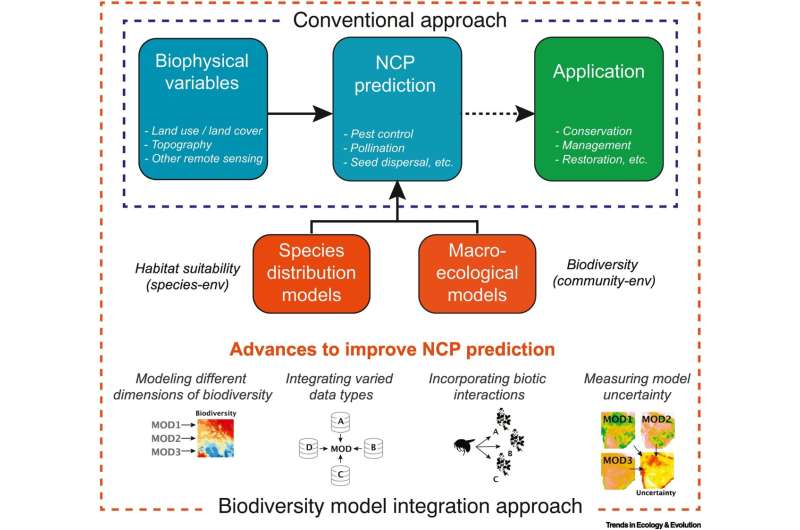This article has been reviewed according to Science X's editorial process and policies. Editors have highlighted the following attributes while ensuring the content's credibility:
fact-checked
peer-reviewed publication
trusted source
proofread
Biodiversity modeling advances to improve predictions of nature's contributions to people

People depend on nature in a multitude of ways. Crop pollination, pest management, storm buffering, and carbon capturing are all part of nature's contributions to people (NCP). But these contributions are subject to change—species that make vital contributions may migrate or even go extinct due to climate change or habitat loss. Forecasting these changes is challenging, but also essential to ensure that humans are adequately prepared to respond.
Part of what makes this so challenging is that current NCP estimates typically rely on data incorporating the physical environment and omit information on species. Given that biodiversity is a cornerstone of NCP, many scientists recognize that biodiversity information can help us better assess the current and future state of NCP.
In a new opinion paper published in Trends in Ecology & Evolution, lead author Jamie M. Kass, associate professor and head of the Macroecology Lab at Tohoku University's Graduate School of Life Sciences, and an international team of colleagues argue that recent advances in biodiversity modeling and mapping have great potential for improving NCP estimates.
"Modeling and mapping of biodiversity advance at a rapid pace, making it difficult for researchers outside the field to keep up," points out Kass. "Our paper overviewed the current challenges in predicting NCP and explained how two major biodiversity modeling strategies can help: species distribution models and macroecological models."
Species distribution models predict species' range limits and habitat suitability based on environmental variables like climate and land use. Macroecological models also use environmental variables but instead predict biodiversity patterns such as the richness of species in an area or how much ecological communities change across a region.
"In the paper we noted that increased adoption of these modeling strategies could allow for a more reliable assessment of the spatial distribution of NCP, for example, by predicting distributions of service-providing species with high biodiversity likely to be important for NCP," adds Kass.
To illustrate their point, the authors outlined how multiple advances for these modeling approaches can be employed to predict different dimensions of pollinator diversity, as well as abundance patterns for predators of crop pests and maps of the associated analytical uncertainty.
The authors conclude these advances will help us forecast changes in NCP that human societies rely on and also meet international goals for biodiversity conservation.
More information: Jamie M. Kass et al, Biodiversity modeling advances will improve predictions of nature's contributions to people, Trends in Ecology & Evolution (2023). DOI: 10.1016/j.tree.2023.10.011
Journal information: Trends in Ecology & Evolution
Provided by Tohoku University




















